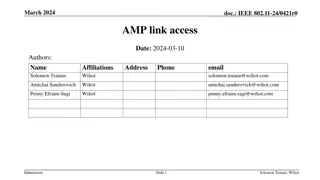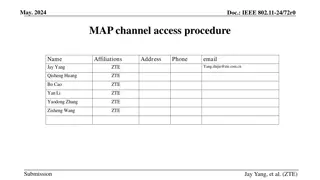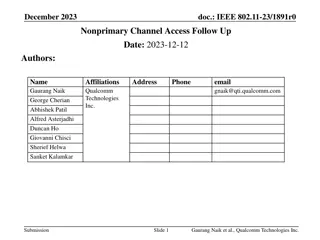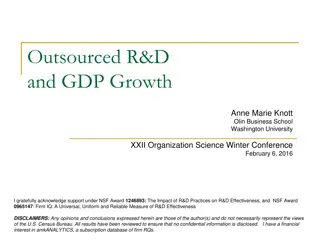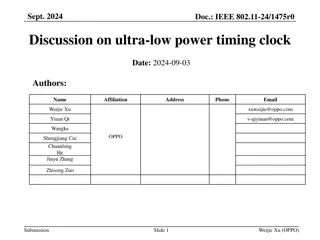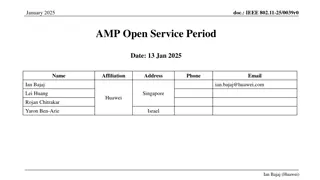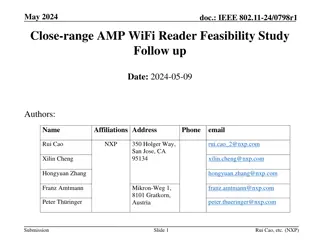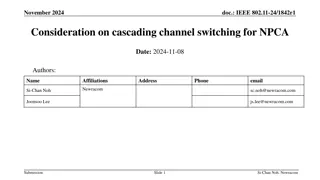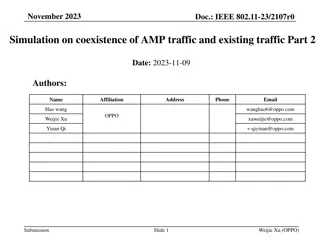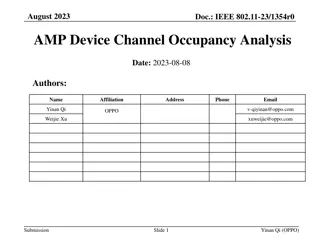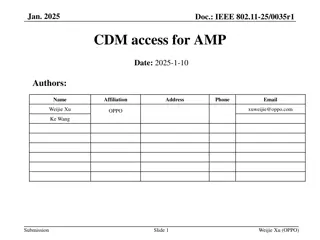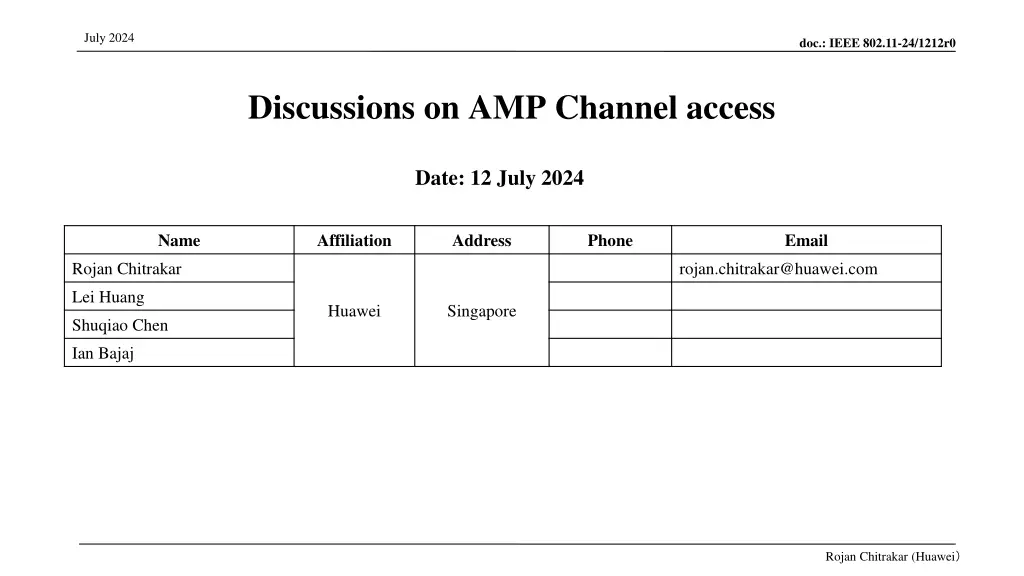
IEEE 802.11-24/1212r0 Discussions on AMP Channel Access
In this document, Rojan Chitrakar from Huawei discusses the challenges and potential solutions for AMP STAs in accessing the wireless medium, focusing on time-slot based random access and TXOP considerations. The proposed scheme involves AMP AP initiating random access sessions and allocating slots based on available TXOP limits. Examples and implications for collision probability are highlighted, emphasizing the need for multiple TXOPs per session.
Download Presentation

Please find below an Image/Link to download the presentation.
The content on the website is provided AS IS for your information and personal use only. It may not be sold, licensed, or shared on other websites without obtaining consent from the author. If you encounter any issues during the download, it is possible that the publisher has removed the file from their server.
You are allowed to download the files provided on this website for personal or commercial use, subject to the condition that they are used lawfully. All files are the property of their respective owners.
The content on the website is provided AS IS for your information and personal use only. It may not be sold, licensed, or shared on other websites without obtaining consent from the author.
E N D
Presentation Transcript
July 2024 doc.: IEEE 802.11-24/1212r0 Discussions on AMP Channel access Date: 12 July 2024 Name Affiliation Address Phone Email Rojan Chitrakar rojan.chitrakar@huawei.com Lei Huang Huawei Singapore Shuqiao Chen Ian Bajaj Rojan Chitrakar (Huawei
July 2024 doc.: IEEE 802.11-24/1212r0 Recap Unlike regular 802.11 STAs, most AMP STAs will not be able to use the existing 802.11 medium access protocols such as EDCA. [1] introduces two types of AP-driven random access: 1) time-based 2) frequency based. Access mode 2 in [2] expands on the time-based random access. Rojan Chitrakar (Huawei Slide 2
July 2024 doc.: IEEE 802.11-24/1212r0 Time-slot based random access We think time based random access is more suitable for AMP STAs however we would like to highlight potential challenges for time-slot based random access and possible work arounds. A potential time-slot based random access scheme: AMP AP gains access to wireless medium and transmits an AMP Poll frame to starts a random access session with 2ECW time slots. Upon receiving the AMP Poll frame, eligible AMP STAs randomly choose a slot and transmit in the slot. Example 1 with ECW = 2 and three backscattering AMP STAs contending: Rojan Chitrakar (Huawei Slide 3
July 2024 doc.: IEEE 802.11-24/1212r0 Time-slot based random access The duration of the TXOP obtained by the AMP AP may limit the available slots for random access. For example, @250kbps data rate, a 20 octets AMP PPDU will require 0.64ms. With the default TXOP limit for AC_BK (2.528ms), at most 3 random access slots can be allocated per TXOP for responders. The number of random access slots per TXOP will likely be small. Since the number of slots available for random access directly impacts the collision probability, a random access session should not be limited to a single TXOP. Rojan Chitrakar (Huawei Slide 4
July 2024 doc.: IEEE 802.11-24/1212r0 TXOP aware Time-slot based random access A first AMP frame (AMP Poll) initiates a random access session and indicates: Session ID the total number of random access slots= 2ECW. Duration of each slot A second AMP frame (AMP Re-Poll) continues the random access session in a different TXOP and indicates: Session ID The range of slots allocated in the TXOP. The range of slots allocated in the TXOP. The AMP AP can flexibly allocate random access slots based on available TXOP limit and expected number of contending AMP STAs. Rojan Chitrakar (Huawei Slide 5
July 2024 doc.: IEEE 802.11-24/1212r0 Time-slot based random access Example 2 with eight random access slots (ECW = 3) spread across two TXOPs and four backscattering AMP STAs contending: Rojan Chitrakar (Huawei Slide 6
July 2024 doc.: IEEE 802.11-24/1212r0 Further Considerations Further thoughts on time based random access for AMP: The efficiency of time-slot based random access mechanism will depend on factors such as AMP STA density, AMP link data rate etc., and further considerations are needed for collision mitigation and recovery mechanism. While time-slot based random access mechanism is simple and may be the only possible option for simple AMP STAs that do not support channel sensing (e.g., CCA), more efficient methods may be possible. E.g., Backoff based random access (similar to CSMA/CA) for AMP STAs that support channel sensing. Instead of using fixed sized time slots, short backoff slots can be used to mitigate contention among STAs. Rojan Chitrakar (Huawei Slide 7
July 2024 doc.: IEEE 802.11-24/1212r0 Conclusion In this contribution we highlighted potential challenges for time-slot based random access and suggested a TXOP aware time-slot based random access. We also shared that more efficient random access methods, such as backoff based random access should also be investigated. Rojan Chitrakar (Huawei Slide 8
July 2024 doc.: IEEE 802.11-24/1212r0 SP 1 Do you agree to add the following text to TGbp SFD? 802.11bp shall support a time-based random access mechanism. Rojan Chitrakar (Huawei Slide 9
July 2024 doc.: IEEE 802.11-24/1212r0 SP 2 Do you agree to add the following text to TGbp SFD? A time-based random access session may span multiple TXOPs. Rojan Chitrakar (Huawei Slide 10
July 2024 doc.: IEEE 802.11-24/1212r0 References [1] 23/827r0, AMP IoT Medium Access (Sebastian Max et. al.). [2] 24/421r0, AMP link access (Solomon Trainin et. al.). Rojan Chitrakar (Huawei Slide 11




